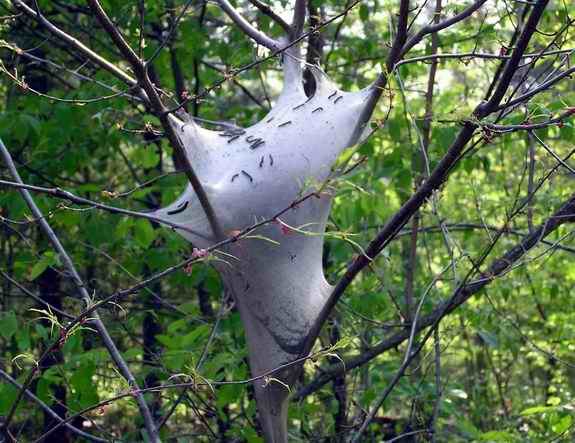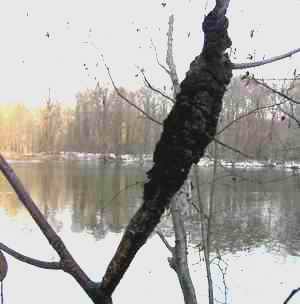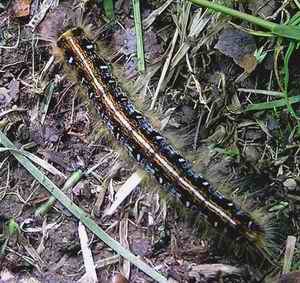|
Common Name: Eastern Tent Caterpillar, Armyworm Scientific Name: Malacosoma americanum (Genus derived from the Greek malaco, a prefix for soft and soma meaning body describing its lack of chitinous structure).
The Eastern Tent Caterpillar is at the very apex of the Lepidoptera for its
almost apian social
In the larval stage, the Eastern Tent Caterpillar has evolved a relatively complex social behavior that contributes to its ubiquity. The cohort of a single egg cache stays together at the crotch where it started and proceeds to erect the tent, starting with a foundation of a few silken threads. The social arrangement of the larval cohort is such that they collaborate in the expansion of the tent according to the size needed to accommodate the colony. They egress from the tent en masse three times during each twenty four hour period in search of food. These expeditions occur just before dawn, at mid-afternoon and at dusk. Each foray consists of a set pattern of adding a layer of silk to the tent, traveling to a feeding site one behind the other along a set route, returning to the tent for protection until the next iteration. The pathways are marked by a pheromone that is produced in the abdomen. Exploratory trails are marked once while outward bound in search of sustenance. Success results in a second mark on the way back to the tent along the same path, creating a recruitment trail to lead subsequent food forays to the spot. They are called armyworms in some areas due to this mass movement.
The primary function of the tent is thermoregulation, the maintenance of the temperature needed for the quantized process of growth by molting. The Eastern Tent Caterpillar requires a body temperature of about 60�F (15�C) to digest food. This is a challenge as the larvae emerge in the early spring when temperatures are frequently much lower. They initially use the radiant heat of the sun combined with basking in large groups to reduce convective heat loss. Once the tent is erected, it operates in a greenhouse-like manner, trapping the heat of the morning sun. It has been demonstrated that massed basking caterpillars can produce temperatures as high as 44�C above ambient, which is dangerously hot. Overheated caterpillars use the thermally heterogeneous layers of the tent to control their temperature. It is also hypothesized that the elevated levels of humidity inside the tent enhance molting.
At the completion of the last instar, the Eastern Tent Caterpillars leave the nest one by one to find an appropriate location to spin a cocoon and to pupate. It is at this point that they are most subject to predators. The large congregations of caterpillars on the tent ward off predators by aposematic displays; their coloration marking their poor palatability. The only birds that regularly feed on the Eastern Tent Caterpillar are the cuckoo and the Blue Jay. The others are deterred by the caterpillar's cyanide laden juices derived from eating the leaves of the cherry tree. The adult moths emerge about two weeks after pupation. Mating, oviposition and death generally occur that same day. |

 practices, centered on the construction, maintenance and utilization of the
silken mass called a tent. Its life cycle follows the four-stage
metamorphosis that is characteristic of butterflies and moths; egg, larva,
pupa and adult. The eggs are laid by female adult moths in the late summer in
the crotch of a tree. These black, varnish-like masses that consist of about
150 to 400 eggs are sufficiently resilient to serve as a palladium against the
ravages of winter. The larvae hatch early in the spring when the buds first
appear. This is due in part to the rapid procession of embryogenesis in the
eggs which results in the formation of fully formed larvae about three weeks
after deposition.
practices, centered on the construction, maintenance and utilization of the
silken mass called a tent. Its life cycle follows the four-stage
metamorphosis that is characteristic of butterflies and moths; egg, larva,
pupa and adult. The eggs are laid by female adult moths in the late summer in
the crotch of a tree. These black, varnish-like masses that consist of about
150 to 400 eggs are sufficiently resilient to serve as a palladium against the
ravages of winter. The larvae hatch early in the spring when the buds first
appear. This is due in part to the rapid procession of embryogenesis in the
eggs which results in the formation of fully formed larvae about three weeks
after deposition. Starting
as small worms, the larvae proceed through six instars (a period of time
between successive molts) as they grow into hairy caterpillars about 2 inches
in length (caterpillar is from the Latin catta pilosa meaning hairy
cat). During this period, they use the tent as a refuge against predation and
the elements. The tent is erected so that the largest area faces to the south
and east to take advantage radiant solar heat. This is because light
stimulates the larvae to produce silk (in laboratory experiments where the
light is artificially placed at the bottom, the tent is built upside down).
The tent is erected in layers that are caused by the quotidian secretions of
the caterpillars on the surface of the tent. The silk layer is initially in
tension, contracting as it dries to separate the layer from the one deposited
on the previous day. The gaps between the layers serve as resting places for
the many individuals in the colony.
Starting
as small worms, the larvae proceed through six instars (a period of time
between successive molts) as they grow into hairy caterpillars about 2 inches
in length (caterpillar is from the Latin catta pilosa meaning hairy
cat). During this period, they use the tent as a refuge against predation and
the elements. The tent is erected so that the largest area faces to the south
and east to take advantage radiant solar heat. This is because light
stimulates the larvae to produce silk (in laboratory experiments where the
light is artificially placed at the bottom, the tent is built upside down).
The tent is erected in layers that are caused by the quotidian secretions of
the caterpillars on the surface of the tent. The silk layer is initially in
tension, contracting as it dries to separate the layer from the one deposited
on the previous day. The gaps between the layers serve as resting places for
the many individuals in the colony.